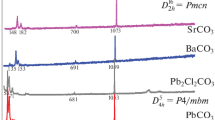Abstract
SPECTROSCOPIC investigations on the scattering of light in crystals show very plainly that their vibration spectra have a discrete structure manifesting itself as a set of lines with sharply defined frequency shifts. That a similar discrete structure is also to be seen in the infra-red absorption spectra of crystals when examined under appropriate conditions is shown by a remarkable investigation by Barnes and Brattain1. These authors examined the case of magnesium oxide, which is a crystal of the cubic class with a structure similar to that of rock-salt. Plates obtained by cleavage from flawless transparent single crystals of large size were employed, and the absorption spectra of a whole series of such plates from the very thinnest obtainable to the thickest were investigated. The rock-salt spectrometer used in the study covered the wave-length range 1–15·6 μ., and the galvanometer deflexions were amplified 150 times by a photo-electric relay system. The resulting data showed the presence of some forty absorption lines in the wave-length range 6–15·5 μ. In the absorption curves reproduced with their paper, these lines are so sharply defined that their positions can be measured with high precision.
Similar content being viewed by others
References
Phys. Rev., 48, 582 (1935).
Proc. Ind. Acad. Sci., 18, 237 (1943).
Author information
Authors and Affiliations
Rights and permissions
About this article
Cite this article
RAMAN, C. Infra-Red Absorption Spectra of Crystals. Nature 161, 165–166 (1948). https://doi.org/10.1038/161165b0
Issue Date:
DOI: https://doi.org/10.1038/161165b0
- Springer Nature Limited




